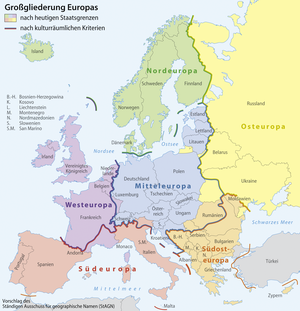Eastern Europe

Proposal by the Standing Committee on Geographical Names to delimit Eastern Europe
With Eastern Europe , the eastern, is Central Europe adjacently located part of Europe called. A more specific definition of the term Eastern Europe depends on the context in which this term is used:
- In a geographical sense, Eastern Europe includes the European part of Russia and the north-western part of Kazakhstan as well as the central and eastern part of Ukraine , while its extreme south-west ( Carpathian Ukraine , Bukovina and Galicia ) is often assigned to Central Europe. The vast majority of Belarus is also included . However, a large part of Eastern Europe is north of Central Europe, cities such as Saint Petersburg ("Venice of the North"), Novgorod and Murmansk are further north than many Scandinavian cities. Northwest Russia was mostly included in Northern Europe until the middle of the 19th century . The most geographically correct term for this area is Northeastern Europe . The dominant landform in Eastern Europe is the huge East European Plain , which, among other things to Eastern Europe from Asia separating Urals extends -Gebirge and north to the icy Arctic Ocean encounters. The eastern border between Eastern Europe and Asia is not clearly defined, especially in the southeast between the Urals and the Black Sea.
- In the historical sense are with Eastern Europe , the Ukraine , the European part of Russia , Belarus and Moldavia called. Occasionally the Caucasian countries Georgia , Armenia and, to a certain extent, Azerbaijan are also seen as part of Eastern Europe. By Christian Giordano and other scientists one of the six is the historical regions of Europe "Eastern Europe" called. The Eastern European countries are historically and culturally largely shaped by the Orthodox Church (with the exception of Islamic Azerbaijan) and - in contrast to the Ottoman- ruled Balkans - were under the rule of the Russian Empire . Like the Balkan countries, the countries of Eastern Europe were backward agricultural states for a long time (see: Intermediate Europe ) and had no or only a limited share in the social developments of the Renaissance , Reformation and Enlightenment in the Western world . The fact that communism first established itself in Russia from 1917 and later, as a result of the Second World War , in other countries and was able to hold its own for a few decades, contradicted the expectations of Marxism as a rather curious development , even if the backwardness of the metropolitan area was a somewhat favorable starting position for one may have offered an independent socialist modernization approach.
- In the ethnic , linguistic and cultural sense, Eastern Europe describes the part of Europe inhabited by the Slavic peoples . This simplified classification is criticized, however, because on the one hand the eastern part of Germany was settled by Slavs for a long time and partly still is today (see Sorbs ) and on the other hand countries such as Hungary , Romania , Moldova and Estonia , and - depending on the definition - also Lithuania and Latvia (see Balto-Slavic hypothesis ) as non-Slavic countries surrounded by Slavic peoples are completely disregarded.
- In a political sense, Eastern Europe referred to the European Eastern Bloc states during the Cold War .
The Eastern European and Central Eastern European countries are often considered together for political reasons. In the EU - jargon the acronym is for CEEC .
- In the statistical sense of the United Nations , Eastern Europe includes : Bulgaria, Moldova, Romania, Russia, Slovakia, Ukraine, Hungary, Poland, the Czech Republic and Belarus. The Baltic states are already part of northern Europe .
- In the linguistic and geographical sense of the United Nations, the Department for Eastern Europe, North and Central Asia comprises the following countries: Armenia, Azerbaijan, Bulgaria, Kyrgyzstan, Mongolia, Russia, Ukraine, Uzbekistan and Belarus.
Eastern Europe was a major area of Eastern Research , which has its beginning in the eastern part of Germany. Many Eastern European countries use Eastern European Time (EET)
See also
literature
- Study Guide Eastern Europe
- Volume 1: History of East Central and Southeast Europe [paperback], ed. by Harald Roth, 2nd revised. and updated edition UTB, Stuttgart 2009, ISBN 3-8252-3167-4 .
- Volume 2: History of the Russian Empire and the Soviet Union [paperback], ed. by Thomas Bohn and Dietmar Neutatz , 2nd revised. and actual Ed., UTB, Stuttgart 2009, ISBN 3-8252-3168-2 .
- Christa Ebert: Literature in Eastern Europe: Russia and Poland. Akademie Verlag, Berlin 2010, ISBN 3-05-004537-X .
Web links
Wiktionary: Eastern Europe - explanations of meanings, word origins, synonyms, translations
- Eastern Europe Department of the Berlin State Library - Prussian Cultural Heritage
- Leibniz Institute for East and Southeast European Studies
- Link collections of the Eastern Europe Network on Eastern Europe in general
- osmikon - The research portal on Eastern, Central Eastern and Southeastern Europe: interdisciplinary information on Eastern European research in German-speaking countries
- Eastern Europe , interdisciplinary monthly magazine for the analysis of politics, economy, society, culture and contemporary history in Eastern Europe (founded 1925)
Individual evidence
- ↑ : Interdependent Diversity: The Historic Regions of Europe. in: Karl Kaser u. a. (Ed.): Europe and the borders in the head , Wieser-Verlag, Klagenfurt 2003, pp. 113-134.
- ↑ Statistics page of the United Nations
- ↑ http://unstats.un.org/unsd/geoinfo/ungegndivisions.htm ( Memento from August 17, 2002 in the Internet Archive )

